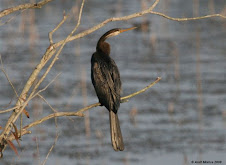

Potatoes – we eat a lot but never discuss about them. They invariably form a part of our daily food ,but alas are never given a thought - we take them for granted.
A very similar plight is that of the Chital or the Spotted Deer. Any person visiting the forest has his first experience of a wild animal in the form of a Chital which is seen the most , in herds, jumping , running and grazing in the grasslands or resting under the shade of the trees. But the eyes keep on looking for the big carnivores and these beautiful and delicate creatures are not given a second thought.
The Chital or Spotted Deer (Axis axis) is one of the most prominent deer species found in India. The are found almost in ever forest of the country but is at its best in the Himalayan foothills , in the jungles of the Terai and in Madhya Pradesh. Its coat is a bright rufus-fawn profusely spotted with white ,at all ages and in all seasons. Old bucks are more brownish in colour and darker. The stag (male) stands at 90 cms at the shoulder and weighs around 85 kgs. The graceful antlers have three tines , a long brow tine set nearly at right angles to he beam and two branch tines at the top. The usual size of a herd is of 10 to 30 animals which may contain two to three stags , but assembly of several hundred have also been seen. They feed till late in the morning and again in the afternoon. These chital have developed a very special relationship with the Rhesus monkeys and Langoors, which on one hand, sitting high in the trees provide the deer with food by dropping leaves and fruits and on the other are the first ones to give an alarm call for the Tiger or Leopard and alert the chitals. Chitals are the primary prey base for the carnivores.
Katerniaghat Wildlife Sanctuary (KWS) has an abundance of chital. In the Katerniaghat Range one can see large herds in the early morning or late afternoon on the Bundha Road. The left of this road are the open grassland where the herds graze with the adult alert at the slightest movement and the young playing around and the right side has water holes which quenches their thirst. There is a constant movement from one side of the bundha to the other.
Katerniaghat has a very special group of chitals , they to the best of my knowledge are the only pairs of Albino Chitals in the wild. Sighting of two male and two female Albino Chital have been reported from the Katerniaghat Range of this forest. These Albino are a one of the Jewels of the Katerniaghat Wildlife Sanctuary.
The Chital or Spotted Deer (Axis axis) is one of the most prominent deer species found in India. The are found almost in ever forest of the country but is at its best in the Himalayan foothills , in the jungles of the Terai and in Madhya Pradesh. Its coat is a bright rufus-fawn profusely spotted with white ,at all ages and in all seasons. Old bucks are more brownish in colour and darker. The stag (male) stands at 90 cms at the shoulder and weighs around 85 kgs. The graceful antlers have three tines , a long brow tine set nearly at right angles to he beam and two branch tines at the top. The usual size of a herd is of 10 to 30 animals which may contain two to three stags , but assembly of several hundred have also been seen. They feed till late in the morning and again in the afternoon. These chital have developed a very special relationship with the Rhesus monkeys and Langoors, which on one hand, sitting high in the trees provide the deer with food by dropping leaves and fruits and on the other are the first ones to give an alarm call for the Tiger or Leopard and alert the chitals. Chitals are the primary prey base for the carnivores.
Katerniaghat Wildlife Sanctuary (KWS) has an abundance of chital. In the Katerniaghat Range one can see large herds in the early morning or late afternoon on the Bundha Road. The left of this road are the open grassland where the herds graze with the adult alert at the slightest movement and the young playing around and the right side has water holes which quenches their thirst. There is a constant movement from one side of the bundha to the other.
Katerniaghat has a very special group of chitals , they to the best of my knowledge are the only pairs of Albino Chitals in the wild. Sighting of two male and two female Albino Chital have been reported from the Katerniaghat Range of this forest. These Albino are a one of the Jewels of the Katerniaghat Wildlife Sanctuary.


.jpg)
No comments:
Post a Comment